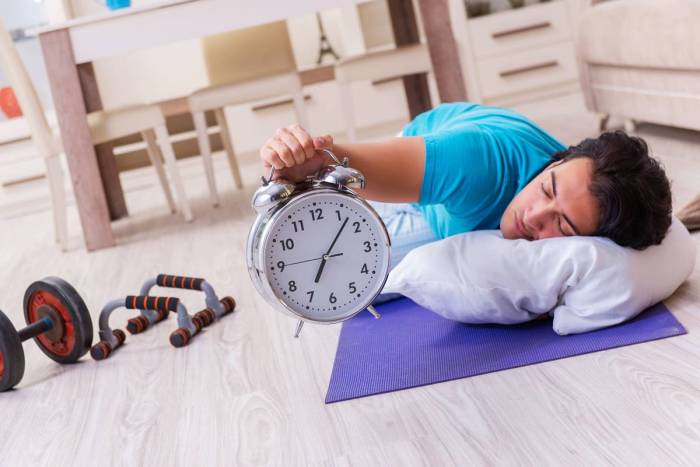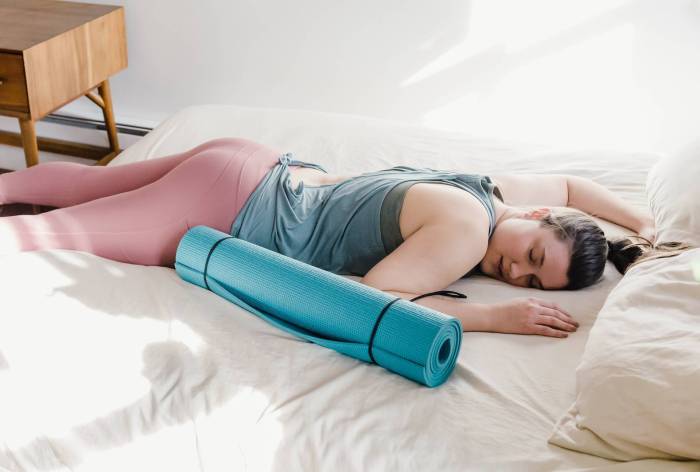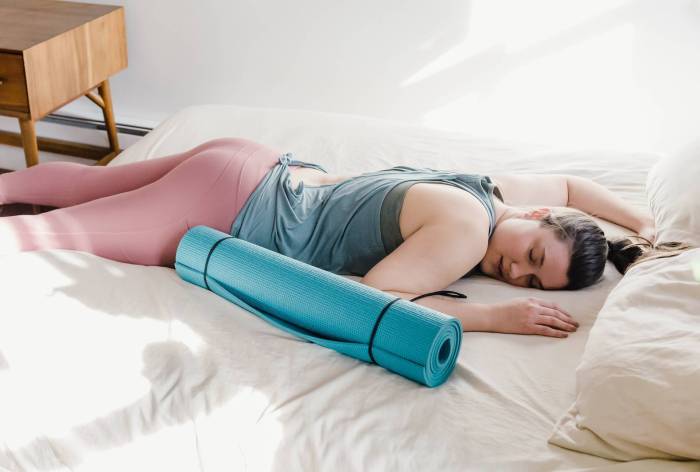How can exercises improve our sleeping quality? This exploration delves into the powerful connection between physical activity and restful sleep. From understanding different exercise types to optimizing your schedule and environment, we’ll uncover the secrets to achieving better sleep through movement.
Improving sleep quality isn’t just about hitting the pillow; it’s about a holistic approach. This post will guide you through the science behind exercise and sleep, showing how different types of workouts, intensity levels, and even your daily routine can significantly impact your nightly rest.
Types of Exercises for Sleep Improvement
Exercise plays a crucial role in optimizing sleep quality. Engaging in regular physical activity can positively impact various aspects of sleep, from promoting relaxation to regulating hormone levels. This section delves into different exercise types and their specific benefits for sleep.
Cardiovascular Exercises for Sleep
Cardiovascular exercises, like running, swimming, or cycling, significantly contribute to better sleep. These activities elevate heart rate, improve circulation, and help regulate body temperature, all of which are beneficial for sleep. Increased blood flow to the muscles and organs during exercise can contribute to improved sleep quality by aiding in the body’s natural sleep-wake cycle.
- Improved circulation: Cardiovascular exercises increase blood flow throughout the body, delivering oxygen and nutrients to the muscles and organs. This enhanced circulation helps regulate body temperature, which is important for falling asleep and staying asleep.
- Stress reduction: Physical activity, particularly cardiovascular exercise, can effectively reduce stress hormones like cortisol. Lower stress levels create a more relaxed state, making it easier to fall asleep and experience a more restful sleep.
- Examples: Jogging, brisk walking, swimming, cycling, dancing.
Strength Training for Sleep
Strength training, involving resistance exercises like weightlifting or bodyweight routines, also contributes to improved sleep quality. Muscle building and toning can help regulate hormones and reduce stress, both of which are crucial for a good night’s sleep. The physical exertion can also lead to a sense of tiredness, making it easier to fall asleep.
- Muscle relaxation: Strength training can promote muscle relaxation, which is crucial for a peaceful sleep. The process of contracting and relaxing muscles during these exercises can contribute to a more relaxed body and mind.
- Hormonal regulation: Strength training can contribute to the regulation of hormones like melatonin, which plays a key role in regulating sleep-wake cycles. Increased muscle mass can also affect hormone balance in ways that contribute to better sleep.
- Examples: Weightlifting, resistance band exercises, bodyweight squats, push-ups, pull-ups.
Flexibility and Stretching Exercises for Sleep
Flexibility and stretching exercises, such as yoga and Pilates, promote relaxation and improve sleep quality. These exercises enhance muscle flexibility, reduce muscle tension, and improve posture, which can contribute to a more comfortable sleep position.
- Muscle tension reduction: Stretching exercises help release muscle tension accumulated throughout the day. Reduced muscle tension contributes to a more relaxed body and mind, leading to improved sleep quality.
- Improved posture: Good posture is essential for comfortable sleep. Stretching exercises can improve posture, reducing discomfort and promoting a more restful sleep position.
- Examples: Yoga, Pilates, tai chi, stretching routines.
Comparison of Exercise Types for Sleep Improvement
| Exercise Type | Impact on Sleep | Specific Benefits | Examples |
|---|---|---|---|
| Cardiovascular | Improved sleep onset and duration | Stress reduction, improved circulation, body temperature regulation | Jogging, swimming, cycling |
| Strength Training | Enhanced sleep quality | Muscle relaxation, hormonal regulation, reduced stress | Weightlifting, bodyweight exercises |
| Flexibility/Stretching | Improved sleep comfort and relaxation | Muscle tension reduction, improved posture, stress relief | Yoga, Pilates, stretching |
Exercise Timing and Duration for Optimal Sleep
Getting enough quality sleep is crucial for overall health and well-being. Regular exercise plays a vital role in improving sleep quality, but the timing and duration of your workouts can significantly impact your ability to fall asleep and stay asleep. Understanding the optimal exercise schedule for your body can lead to better sleep patterns and overall improved health.The ideal time for exercise to maximize sleep benefits is contingent on individual sleep patterns.
While a consistent exercise routine is generally beneficial, the time of day when you exercise can impact your sleep. Factors such as your body’s natural sleep-wake cycle (circadian rhythm) and individual sensitivities to exercise-induced physiological changes need to be considered.
Ideal Time of Day for Exercise
The timing of your workout is important for maximizing sleep benefits. Generally, exercising too close to bedtime can interfere with sleep onset. The physiological arousal from exercise can take time to subside. Early morning or afternoon workouts are often more conducive to improved sleep. However, the most suitable time depends on individual preferences and the body’s response to exercise.
For example, some individuals find that early morning workouts energize them, while others might find evening workouts help them relax and unwind before bed.
Optimal Duration of Exercise Sessions
The duration of exercise sessions plays a crucial role in sleep enhancement. While any amount of exercise is better than none, excessively long or strenuous workouts, particularly close to bedtime, can lead to difficulty falling asleep. Moderate-intensity exercise sessions of 30-60 minutes are generally considered optimal for sleep improvement. It’s essential to listen to your body and adjust the duration of your workouts based on your individual fitness level and tolerance.
Guidelines for Adjusting Exercise Schedules
Individual sleep patterns and sensitivities to exercise need to be considered. Pay close attention to how your body responds to different exercise times and durations. If you notice that a particular exercise time or duration consistently affects your sleep, adjust your schedule accordingly. For example, if evening workouts make it difficult to fall asleep, try shifting your workouts to the morning or afternoon.
Experimentation and observation of your body’s responses are key to finding the ideal exercise schedule. Listen to your body and make adjustments as needed.
Exercise Schedules and Potential Impact on Sleep Quality
| Exercise Schedule | Exercise Type | Duration (minutes) | Estimated Sleep Improvement |
|---|---|---|---|
| Morning (6:00 AM – 8:00 AM) | Brisk walking, jogging, yoga | 30-45 | Improved sleep onset and duration, reduced sleep disturbances |
| Afternoon (12:00 PM – 2:00 PM) | Cycling, swimming, strength training | 45-60 | Improved sleep quality, reduced daytime sleepiness |
| Evening (6:00 PM – 8:00 PM) | Light stretching, yoga, walking | 30-45 | Improved sleep quality, reduced difficulty falling asleep (provided not too strenuous or close to bedtime) |
Note: These are general guidelines. Individual responses to exercise vary. Consult with a healthcare professional for personalized recommendations. Always listen to your body.
Exercise Intensity and Sleep Quality

Finding the right balance between exercise and sleep is crucial for overall well-being. While physical activity is vital for a healthy lifestyle, the intensity and timing of workouts can significantly impact sleep patterns. Understanding how different exercise intensities affect our bodies is key to optimizing our sleep routines.Exercise intensity plays a significant role in influencing sleep quality. Moderate-intensity exercise generally promotes better sleep, while excessive or inadequate intensity can disrupt it.
The ideal intensity for sleep improvement is one that leaves you feeling invigorated but not overly tired or stimulated before bed.
High-Intensity Interval Training (HIIT) and Sleep
HIIT workouts, characterized by short bursts of intense exercise followed by brief recovery periods, can have a complex relationship with sleep. While HIIT can improve cardiovascular health and overall fitness, the intensity and physiological stress it induces might lead to difficulty falling asleep or maintaining sleep, especially if performed too close to bedtime. This is due to the elevated heart rate and hormonal responses triggered by the exercise.
Studies suggest that the effects of HIIT on sleep vary depending on individual factors such as fitness level and sleep hygiene practices.
Low-Intensity Workouts and Sleep
Low-intensity workouts, such as brisk walking or light cycling, are generally considered more conducive to sleep. The sustained, moderate exertion doesn’t elevate heart rate and stress levels as drastically as HIIT, potentially leading to a more relaxed and restful sleep experience. The lower intensity allows the body to recover more effectively, which in turn contributes to improved sleep quality.
Potential Risks of Excessive Exercise and Sleep
Excessive exercise, regardless of intensity, can negatively impact sleep. Overtraining syndrome, characterized by chronic fatigue and impaired sleep, is a potential risk. Overtraining can lead to imbalances in the body’s hormonal and physiological systems, disrupting the natural sleep-wake cycle. Furthermore, excessive exercise can result in muscle soreness and pain, making it harder to relax and fall asleep.
It is important to listen to your body and avoid pushing yourself beyond your limits.
Exercise Intensity, Heart Rate, and Sleep Duration
The following table illustrates a potential correlation between exercise intensity, heart rate, and sleep duration. It is important to remember that these are estimates, and individual responses can vary significantly.
| Exercise Intensity | Estimated Heart Rate (bpm) | Potential Effect on Sleep Duration (hours) |
|---|---|---|
| Low-intensity (e.g., brisk walking) | 60-70 | 7-9 |
| Moderate-intensity (e.g., jogging) | 70-85 | 7-8 |
| High-intensity (e.g., HIIT) | 85-95+ | 6-7 (potential disruption) |
Note: These are estimations. Individual responses to exercise and sleep can vary widely. Consult with a healthcare professional for personalized recommendations.
Exercise and Sleep Hygiene Practices
Improving sleep quality isn’t just about finding the right exercise routine; it’s also about integrating it into a broader sleep-friendly lifestyle. Effective sleep improvement often requires a multi-faceted approach, combining physical activity with consistent sleep hygiene practices. This synergy significantly enhances the benefits of exercise, leading to more restful and restorative sleep.A holistic approach to sleep involves more than just hitting the gym.
Sleep hygiene practices, when combined with regular exercise, create a powerful synergy that optimizes sleep quality. These complementary practices work together to create a conducive environment for restful sleep, allowing the body to recover and recharge effectively.
Importance of Combining Exercise with Sleep Hygiene
Consistent sleep hygiene practices are crucial for optimizing the impact of exercise on sleep. Exercise, while beneficial, can sometimes disrupt sleep if not properly managed alongside sleep hygiene. This combination ensures that the body’s physiological response to exercise aligns with the need for restful sleep. For example, a late-night workout without adequate preparation and cooling down can interfere with melatonin production, hindering the natural sleep-wake cycle.
A well-structured routine, encompassing both exercise and sleep hygiene, is key to maximizing the positive effects on sleep quality.
Regular exercise can significantly improve sleep quality, boosting energy levels and overall well-being. Just like mastering a challenging hand in a card game, consistent effort in physical activity builds resilience and a sense of accomplishment, much like what things house cards taught about success highlights. This focus on consistent action, whether it’s on the playing field or in the gym, ultimately leads to better sleep, and a more fulfilling life overall.
Sleep Hygiene Practices Enhancing Exercise’s Effect on Sleep
Consistent sleep hygiene is a powerful tool for maximizing the benefits of exercise. Here’s a list of practices that complement and enhance the effectiveness of exercise on sleep quality:
- Consistent Sleep Schedule: Maintaining a regular sleep-wake cycle, even on weekends, helps regulate the body’s natural sleep-wake rhythm. This consistency helps align the body’s internal clock with external cues, promoting better sleep quality. A consistent sleep schedule helps prepare the body for sleep and enhances the effectiveness of exercise on sleep.
- Relaxation Techniques: Practices like deep breathing exercises, meditation, or progressive muscle relaxation can reduce stress and anxiety, which often interfere with sleep. This can reduce the impact of exercise-induced stress on sleep quality.
- Creating a Conducive Sleep Environment: A dark, quiet, and cool bedroom environment promotes relaxation and sleep. Creating this environment, combined with exercise, helps the body transition into a sleep-ready state more effectively.
- Limiting Screen Time Before Bed: The blue light emitted from electronic devices can suppress melatonin production, hindering sleep onset. Limiting screen time before bed, along with exercise, can help the body naturally prepare for sleep.
- Avoiding Large Meals and Caffeine Before Bed: Consuming large meals or caffeine close to bedtime can disrupt sleep. Avoiding these before exercise and sleep promotes better sleep quality.
Comparing and Contrasting Exercise and Sleep Hygiene
Both exercise and sleep hygiene play critical roles in improving sleep quality. Exercise promotes physical health, contributing to a more balanced sleep-wake cycle. Sleep hygiene practices, on the other hand, focus on creating an environment and habits conducive to sleep. The combination of the two yields greater effectiveness than either alone. Exercise can positively influence sleep hygiene by promoting relaxation and reducing stress, while sleep hygiene practices, like a consistent sleep schedule, can enhance the recovery benefits of exercise.
How Exercise and Sleep Hygiene Practices Work Together
The table below illustrates how exercise and sleep hygiene practices work together to improve sleep quality.
| Practice | Mechanism | Impact on Sleep |
|---|---|---|
| Regular Exercise | Reduces stress, improves physical health, strengthens the body’s natural sleep-wake cycle | Enhanced sleep duration, increased sleep quality, improved sleep onset |
| Consistent Sleep Schedule | Regulates the body’s natural sleep-wake cycle, preparing the body for sleep | Improved sleep consistency, reduced sleep latency |
| Relaxation Techniques | Reduces stress and anxiety, promoting relaxation and calmness | Improved sleep quality, reduced sleep disturbances |
| Sleep Environment | Creates a conducive environment for sleep, promoting relaxation | Enhanced sleep onset and maintenance, reduced sleep disruptions |
| Avoiding Caffeine/Large Meals Before Bed | Reduces the body’s stimulation close to bedtime | Improved sleep onset, reduced sleep disturbances |
Exercise and Sleep Disorders
Regular exercise is a powerful tool for improving sleep quality, but its impact extends beyond healthy sleepers. For individuals grappling with sleep disorders, exercise can offer significant benefits in managing symptoms and improving overall well-being. Understanding how exercise can address specific sleep disorders and developing personalized exercise plans is crucial for maximizing its positive effects.Exercise can play a vital role in managing insomnia, a common sleep disorder characterized by difficulty falling asleep, staying asleep, or experiencing poor-quality sleep.
Physical activity can help regulate the body’s natural sleep-wake cycle, reducing the time it takes to fall asleep and improving sleep duration and quality. This, in turn, can alleviate the feelings of exhaustion and irritability often associated with insomnia. By increasing energy expenditure and promoting relaxation, exercise helps create a more conducive environment for sleep.
Managing Insomnia with Exercise
Consistent physical activity can significantly improve sleep quality in individuals with insomnia. Regular exercise helps regulate the body’s natural sleep-wake cycle, promoting deeper, more restorative sleep. It’s crucial to note that exercise timing and intensity are key factors in optimizing sleep benefits. Avoid intense exercise close to bedtime, as it can have the opposite effect. Finding the right balance is important.
Benefits for Other Sleep Disorders
Beyond insomnia, exercise can offer potential benefits for other sleep disorders. For example, exercise can help alleviate some symptoms of sleep apnea, a disorder characterized by pauses in breathing during sleep. By improving overall cardiovascular health and promoting better sleep quality, exercise can contribute to managing sleep apnea symptoms. Furthermore, exercise can help individuals with restless legs syndrome (RLS) manage their symptoms, although more research is needed to definitively establish the relationship between exercise and RLS.
Importance of Professional Consultation
Before embarking on any exercise program for sleep improvement, especially if you have a sleep disorder, it’s essential to consult with a healthcare professional. They can assess your specific needs and limitations, recommend appropriate exercises, and monitor your progress. A healthcare professional can tailor an exercise program to your individual situation, considering factors such as underlying medical conditions, medications, and the severity of your sleep disorder.
Regular exercise can significantly boost your sleep quality, but sometimes, despite our best efforts, we still struggle. Just like unwanted situations will keep happening until you learn your lesson , poor sleep habits might keep recurring until we understand the underlying causes. Perhaps you’re not incorporating enough physical activity into your routine, or maybe your bedtime routine needs tweaking.
Regardless, consistent exercise can be a powerful tool for better sleep.
This personalized approach ensures that the exercise program is safe and effective for you.
Personalized Exercise Plan for Sleep Improvement
| Sleep Disorder | Exercise Type | Frequency | Intensity | Duration | Timing |
|---|---|---|---|---|---|
| Insomnia | Moderate-intensity aerobic exercise (e.g., brisk walking, swimming) | 3-5 times per week | Moderate (on a scale of 1-10, 5-7) | 30-60 minutes | At least 2-3 hours before bedtime |
| Sleep Apnea | Cardiovascular exercises (e.g., jogging, cycling) | 3-5 times per week | Moderate to vigorous (on a scale of 1-10, 7-9) | 30-60 minutes | At least 2-3 hours before bedtime |
| Restless Legs Syndrome | Light to moderate-intensity exercise (e.g., yoga, stretching) | 3-5 times per week | Light to moderate (on a scale of 1-10, 2-5) | 30-60 minutes | At least 2-3 hours before bedtime |
Note: This table provides general guidelines. Consult with a healthcare professional for personalized recommendations. Exercise intensity should be adjusted based on individual fitness levels and medical conditions.
Exercise and Mental Health
Exercise isn’t just about physical fitness; it plays a crucial role in our mental well-being, significantly impacting our sleep quality. A healthy mind often leads to a healthy sleep cycle, and vice versa. The connection between physical activity and mental health is multifaceted, influencing everything from stress levels to mood regulation. Understanding this connection is key to optimizing our sleep habits.Maintaining a positive mental state is directly linked to better sleep.
When we’re feeling stressed, anxious, or depressed, our bodies produce hormones that interfere with the natural sleep-wake cycle. Regular exercise, however, can help regulate these hormones, creating a more conducive environment for restful sleep.
The Link Between Exercise and Mental Health
Exercise has a demonstrably positive effect on mental health. Physical activity releases endorphins, often referred to as “feel-good” hormones. These chemicals have mood-boosting effects, reducing feelings of anxiety and depression. This mood elevation is often associated with improved sleep quality. Regular exercise can help alleviate symptoms of stress and anxiety, creating a more relaxed state that facilitates falling asleep and staying asleep.
By reducing stress, exercise contributes to a more stable sleep cycle.
Stress Management Through Exercise
Exercise is a powerful tool for managing stress. Physical exertion allows the body to release pent-up energy and tension, thereby reducing stress hormones like cortisol. This stress reduction directly contributes to improved sleep quality. When stress levels are lower, the body can better regulate its natural sleep-wake cycle, leading to more consistent and restful sleep.
Exercise’s Impact on Mood and Sleep
Exercise significantly impacts mood, which in turn influences sleep. Regular physical activity can lead to increased energy levels, improved self-esteem, and a greater sense of accomplishment. These positive feelings contribute to a more positive outlook, making it easier to fall asleep and experience a more restful night’s sleep. Improved mood, in turn, reduces the likelihood of negative thoughts and worries that can interfere with sleep.
Exercise, Stress, and Sleep Quality
| Exercise Frequency | Stress Levels | Sleep Quality |
|---|---|---|
| Low (less than 2 times per week) | Potentially high | Potentially poor |
| Moderate (2-3 times per week) | Moderately low | Improved |
| High (4+ times per week) | Low | Excellent |
This table illustrates a general trend. Individual responses to exercise can vary, and factors like intensity, type of exercise, and individual health conditions can also play a significant role. Consistency in exercise is crucial for experiencing the full benefits on stress, mood, and sleep.
Exercise and Diet: How Can Exercises Improve Our Sleeping Quality
Fueling your body properly is crucial for maximizing the benefits of exercise, especially when it comes to sleep. A balanced diet provides the necessary nutrients for optimal muscle recovery and energy levels, directly impacting the quality of your sleep. Poor nutrition can lead to fatigue, disrupted sleep cycles, and a general feeling of unwellness, hindering the positive effects of exercise on your overall health.
Therefore, understanding how food and drinks affect your sleep and implementing a meal plan that complements your exercise routine is essential for achieving restful nights.
Impact of Foods and Drinks on Sleep Quality
Certain foods and beverages can significantly influence your sleep patterns. For instance, consuming large meals close to bedtime can disrupt digestion, leading to discomfort and difficulty falling asleep. High-fat or sugary foods can cause blood sugar fluctuations, interfering with sleep quality. Similarly, caffeine and alcohol, though consumed throughout the day, can impact your sleep if consumed too close to bedtime.
Caffeine, a stimulant, can keep you awake, while alcohol, initially promoting relaxation, can disrupt deeper stages of sleep later in the night. Hydration is crucial for overall well-being and sleep, but consuming excessive liquids before bed can lead to frequent nighttime awakenings.
Nutritious Foods to Enhance Exercise-Sleep Benefits
Proper nutrition plays a key role in supporting your exercise routine and promoting better sleep. Consuming foods rich in essential nutrients like protein, complex carbohydrates, and healthy fats will help with muscle repair and energy regulation. These nutrients are critical for post-workout recovery and maintaining stable blood sugar levels throughout the night. Examples of nutritious foods that can enhance the sleep benefits of exercise include lean proteins like chicken or fish, whole grains like brown rice or quinoa, fruits like berries, and vegetables like spinach.
Meal Plan for Exercise and Sleep
A well-structured meal plan can significantly complement your exercise routine and promote better sleep. This plan considers the timing of meals in relation to your workouts and prioritizes foods that support muscle recovery and stable blood sugar levels. This table illustrates a sample meal plan that aligns with an exercise routine, incorporating sleep-promoting foods and avoiding detrimental ones.
| Time | Meal/Snack | Food Choices | Rationale |
|---|---|---|---|
| 2-3 hours before exercise | Breakfast/Brunch | Oatmeal with berries and nuts, Greek yogurt with fruit, whole-wheat toast with avocado | Provides sustained energy for your workout without causing an immediate blood sugar spike. |
| Immediately after exercise | Post-workout snack | Protein shake with fruit, a handful of almonds, a small portion of lean turkey or chicken breast | Helps with muscle recovery and replenishes glycogen stores. |
| Dinner | Dinner | Lean protein (fish, chicken, or tofu) with a portion of complex carbohydrates (brown rice, quinoa, or sweet potato) and plenty of vegetables | Provides balanced nutrition for energy and muscle recovery. |
| 2-3 hours before bed | Light snack | Greek yogurt with a small handful of berries, a piece of whole-wheat toast with a thin layer of nut butter, or a small bowl of oatmeal | Provides a light snack to prevent hunger pangs but avoids foods that can disrupt sleep. |
| Avoid | Sugary drinks, processed foods, caffeine, alcohol | These foods can interfere with sleep quality by causing blood sugar fluctuations or acting as stimulants/depressants. | Prioritize nutrient-dense foods over processed foods. |
Exercise and Circadian Rhythms
Exercise plays a crucial role in regulating our internal body clocks, also known as circadian rhythms. These rhythms dictate our sleep-wake cycles, influencing various bodily functions. A well-established circadian rhythm promotes consistent sleep patterns and overall well-being. Disruptions in these cycles can lead to sleep disorders and other health problems. Understanding how exercise interacts with circadian rhythms is essential for optimizing sleep and improving overall health.Exercise can effectively synchronize our internal clocks with the external environment, promoting healthy sleep-wake cycles.
This synchronization occurs through various mechanisms, including changes in body temperature, hormone levels, and neurotransmitter activity. The impact of exercise on circadian rhythms is particularly relevant to those with irregular sleep patterns, jet lag, or shift work schedules.
Impact of Exercise on Circadian Rhythms
Exercise, especially vigorous activity, can significantly influence the timing and duration of sleep. The relationship between exercise and sleep is multifaceted, involving complex interactions within the body. Factors such as the type, intensity, and timing of exercise all contribute to the effects on sleep. The body’s response to exercise is a complex interplay of physiological changes.
Relationship Between Exercise, Light Exposure, and Sleep Patterns
Light exposure is a critical component of circadian rhythm regulation. Exposure to bright light, particularly during the day, helps to reset the body’s internal clock and promote wakefulness. Conversely, reduced light exposure in the evening helps to promote sleepiness. Exercise performed in natural light, especially during the day, can enhance the body’s ability to synchronize with the natural light-dark cycle.
Regular exercise is a game-changer for better sleep. It boosts energy levels throughout the day, but more importantly, it helps regulate your body’s natural sleep-wake cycle. Finding ways to cultivate healthy relationships, like exploring the 10 secrets making lifelong friends , can also contribute to a peaceful mind, which in turn, supports quality sleep. Ultimately, incorporating physical activity into your routine is key for a more restful and rejuvenating night’s sleep.
This synchronization is critical for establishing healthy sleep patterns.
Exercise Timing and the Sleep-Wake Cycle
The timing of exercise can significantly impact sleep quality. Exercising too close to bedtime can interfere with sleep onset. The body’s physiological response to exercise, including increased body temperature and elevated adrenaline levels, can make it harder to fall asleep. Conversely, early morning or afternoon exercise can have a positive effect on sleep, promoting better sleep quality and duration.
This is particularly important for those who struggle with falling asleep or maintaining sleep throughout the night.
Exercise Schedules and Circadian Rhythm
| Exercise Schedule | Potential Impact on Circadian Rhythm | Potential Impact on Sleep |
|---|---|---|
| Morning (6-9 AM) | Positive synchronization with the natural light-dark cycle. | Improved sleep onset and duration. |
| Afternoon (12-4 PM) | Generally less disruptive to circadian rhythm, depending on intensity. | Potentially good for improving sleep quality, but can impact sleep onset if intensity is too high. |
| Evening (6-9 PM) | Increased risk of disrupting the sleep-wake cycle, especially if exercise is vigorous. | Potentially interferes with sleep onset and quality, especially for those sensitive to exercise-induced physiological changes. |
| Late Evening/Night (9 PM onwards) | Significant risk of disrupting circadian rhythm. | High likelihood of difficulty falling asleep and maintaining sleep. |
This table illustrates the potential impact of different exercise schedules on circadian rhythm and sleep. The optimal exercise time depends on individual preferences and sensitivities. Factors like intensity, duration, and individual responses should be considered when selecting an exercise schedule.
Exercise and Sleep Environment

A conducive sleep environment plays a crucial role in maximizing the sleep benefits of exercise. Just as a well-equipped gym fosters better workouts, a sleep sanctuary optimizes the restorative effects of sleep after physical activity. The right conditions can enhance sleep quality, potentially counteracting the negative effects of stress from strenuous exercise, thereby promoting a more restful and rejuvenating sleep experience.A well-designed sleep environment considers various factors, including temperature, noise levels, and light exposure.
These factors directly impact sleep quality and can either hinder or aid in the restorative process after exercise. Understanding these factors and how to adjust them is key to making the most of your exercise-sleep relationship.
Optimizing Temperature for Sleep, How can exercises improve our sleeping quality
Maintaining the right temperature is crucial for sleep. A slightly cool room temperature, ideally between 60-68°F (15-20°C), is often considered optimal for sleep. This is because a drop in body temperature during sleep is a natural process that facilitates the transition to sleep. Exercise, however, raises body temperature, and if the room is too warm, the body may struggle to cool down, leading to difficulty falling asleep or maintaining sleep.
Managing Noise Levels for Better Sleep
Noise, even low-level background noise, can disrupt sleep patterns. A quiet environment is conducive to sleep after exercise, allowing the body to fully recover. Consider using earplugs, white noise machines, or sound-absorbing materials to minimize disruptive sounds. The sound of a running fan, for instance, can create a calming atmosphere, especially for individuals sensitive to noise.
Light Exposure and Sleep Quality
Light exposure, especially blue light emitted from electronic devices, can significantly affect the sleep-wake cycle. Exposure to light before bed can suppress the production of melatonin, a hormone crucial for sleep. Create a dark and quiet sleep environment, minimizing light exposure by using blackout curtains, eye masks, or dimming lights before bed. Even a small amount of light can interfere with the sleep-wake cycle, so it’s crucial to eliminate light sources.
Sleep Environment Optimization for Post-Exercise Sleep
To optimize your sleep environment for post-exercise sleep, consider these strategies:
- Adjust room temperature: Maintain a cool room temperature (60-68°F) to facilitate body temperature regulation after exercise.
- Minimize noise: Use earplugs, white noise machines, or sound-absorbing materials to create a quiet environment conducive to sleep.
- Control light exposure: Use blackout curtains, eye masks, or dim lights before bed to minimize light exposure, especially blue light from electronic devices.
- Choose comfortable bedding: Opt for a comfortable mattress and pillows that support your body’s needs and preferences. Consider the material of the bedding, as well as its overall support and comfort.
Comparison of Sleep Environment Factors and Impact on Sleep Quality After Exercise
| Sleep Environment Factor | Impact on Sleep Quality After Exercise | Examples of Optimization |
|---|---|---|
| Temperature | Too warm can hinder body temperature regulation, leading to difficulty falling asleep or staying asleep. A cool room promotes relaxation and sleep. | Adjust thermostat, use fans, dress appropriately for sleep. |
| Noise | Disruptive sounds can disrupt sleep patterns, leading to fragmented or restless sleep. A quiet environment fosters better sleep quality. | Use earplugs, white noise machines, soundproofing materials. |
| Light | Exposure to light, particularly blue light, can suppress melatonin production, impacting the sleep-wake cycle. Darkness promotes melatonin production, aiding in sleep initiation and maintenance. | Use blackout curtains, eye masks, dim lights before bed, avoid electronic devices before sleep. |
Epilogue
In conclusion, the link between exercise and sleep is undeniable. By incorporating the right exercises into your routine, considering timing and intensity, and combining them with good sleep hygiene practices, you can unlock a more restful and rejuvenating sleep experience. Remember to prioritize your well-being by listening to your body and consulting a healthcare professional if needed. The path to better sleep is within reach!











